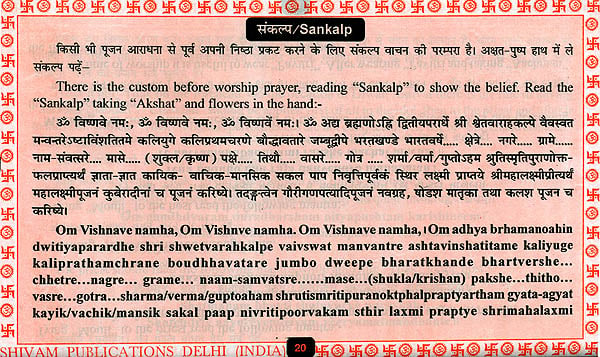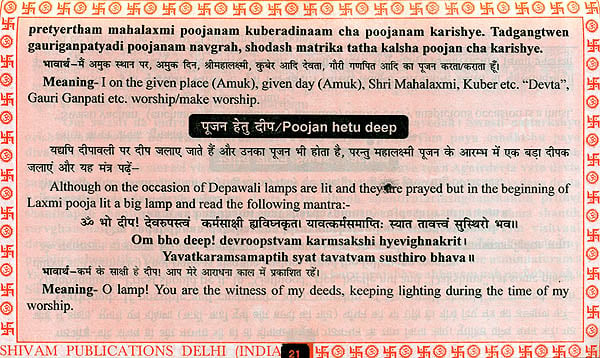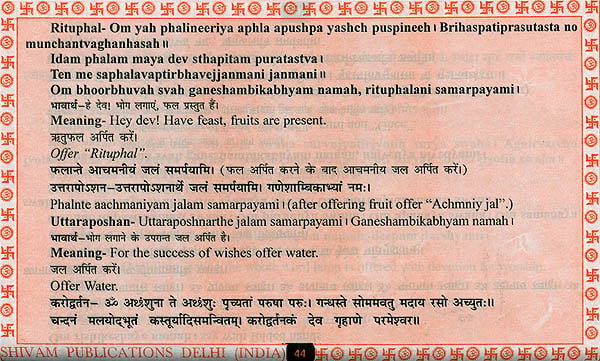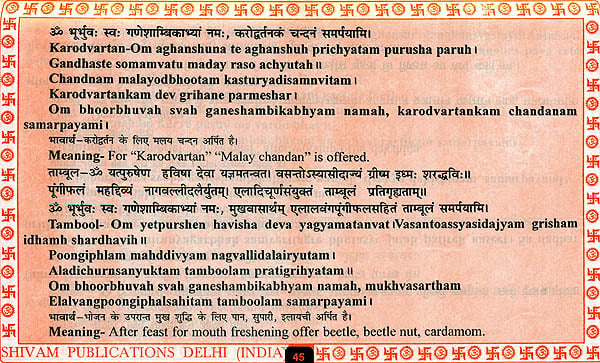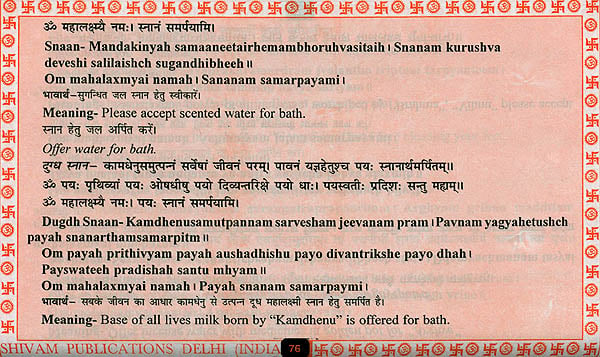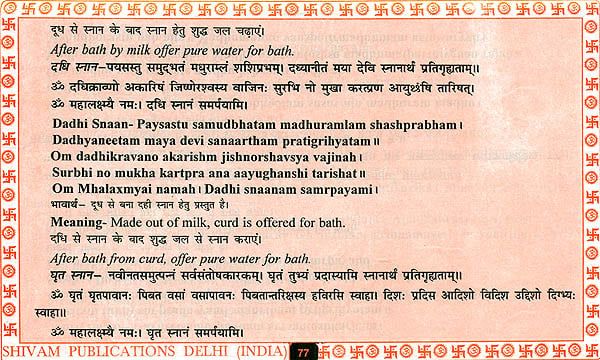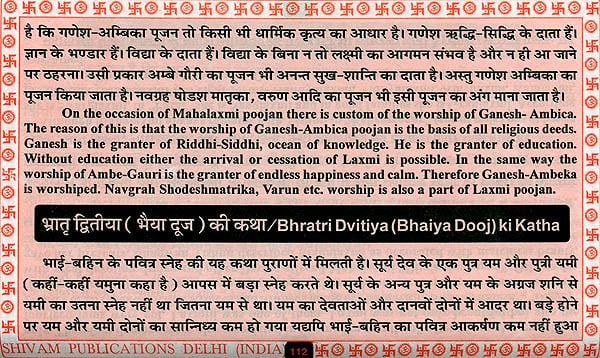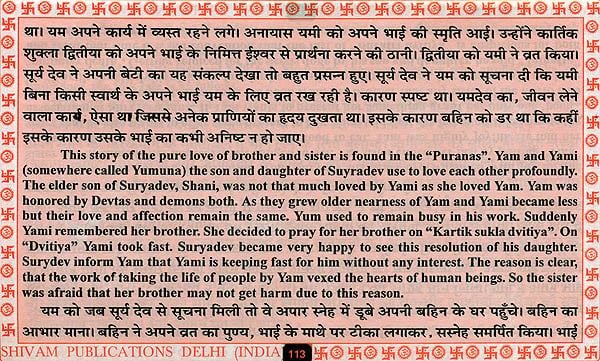
How to Worship Goddess Lakshmi, Shri Mahalakshmi Deepawali Poojan Vidhan (Shri Lakshmi Pooja Padhati) (Sanskrit, Roman with Simple Hindi-English Meaning)
Book Specification
| Item Code: | IHJ038 |
| Author: | Rajiv Tiwariand Translated by Pd. Prem Shanker Shuklaji |
| Publisher: | SHIVAM PUBLICATIONS |
| ISBN: | 9788190646567 |
| Pages: | 128 |
| Cover: | Paperback |
| Other Details | 5.6 inch X 8.5 inch |
| Weight | 180 gm |
Book Description
Among so many specialties of India, one of them is—at the moment of joy and happiness maintain the emotion of gratitude by prayer of God. Under this convention followers of “Sanatan Dhram” on the occasion of Vijayadashmi, Dipawali, Holi, Rakshabandhan etc., pray the concerned deity, because the followers of “Sanatan Dhram” on almost every festival perform religious worship. So in Sanatani Shashtras the mode of worship is also specified, this book written on the basis of religious “Karam Kand” and other conventions depicts the religious importance of “Deepmalika”.
Commonly the worship of every festival has its own importance but, Mahalaxrni Deepawali worship has a special importance. Besides the worship of Mahalaxmi according to Shashtras common festivals like Dhantares, Narak Choudas, Deepawali, Annkoot (Goverdhan pooja) and Bhai Dooj are easily performed by religious minded men and women, but according to “Skandpuran” the worship of Ganesh, Gauri poojan, Navgrah poojan, Kalash poojan, if with them Mahalaxmi’s Shashtriya way of worship also attached it becomes convenient.
One thing more, commonly able priests are not available and the worship of Mahalaxmi, Ganesha etc. deity’s has to be performed in proper method. Therefore, present book has been prepared keeping in view the requirement of self worshipers and learned priests. As far as possible the meanings of mantras and useful notes have also been included to help devotees and priests.
We hope, our effort will be considered as useful. We invite, in this respect, your valuable.
Shri Mahalaxmi festival is a bunch of five common festivals. It is known as Deepawali, diwali and Mahalaxmi festival. This festival is performed with great enthusiasm in the states of Gujarat Maharashtra, Rajasthan, Punjab. Madhya Pradesh, Uttar Pradesh, Uttaranchal, Bihar, Himachal Pradesh, Haryana and Jammu etc. Mahalaxmi poojan is also performed in different way in the states of Bangal Assam Orissa and South India.
The custom of Shri Mahalaxmi worship is very old. according to Pauranik literature Laxmi was found after Samudra manthan the gain of Mahalaxmi due to the common effort of Devas and Demons points out towards the fact that laxmi riches is got through the common effort of the powerful and ht week. Puran says that when Laxmi appeared it was presented to Bhagwan Vishnu. It denotes that laxmi (riches) should be kept in the hands of such a chief who may take care of all properly. The Sanatan dharmi’s imagine tridev Brahma the creator of universe. Vishnu the protector of the universe and Shiva the destroyer of this creation. So it was pertinent to present Laxmi to Shri Vishnu.
The performers of five common festivals start worshipping of this festival from the Trayodashi of Krsihanpaksh of the month of Kartik Dhanterash is the first festival.
Dhantaresh Dhantaresh festival is performed by the purchase of useful thing. On this day the older people of the family purchase some useful thing by the name of Grahlaxmi commonly utensils are purchased. In the evening lamps of ghee and oil are lit. convention is that on that day lamps are lit in the evening for the sake of Yama Houses should be cleaned to receive Mahalaxmi with great enthusiasm. House should be decorated in an attractive way.
The great Vaidya Dhanvantari (the Vaidya of devas) was also born on Trayodashi. Therefore lamps should be lit in the memory of dhanvantari. It is written in Puranas that one who lights lamps on taryodashi has no untimely death. The idea is that one who maintains his health according to the rules of Ayurveda how can be die untimely?
Roop Chaudas If the health is good then it needs to be decorated and adorned Kartik Krishan Chaturdashi is known as Roop Chaudas. This day body is specially taken care of. The body is purified by oil massage and using past prepared by various useful medicines. The idea is that at the welcome of Mahalaxmi the devotee should remain healthy and full of joy.
Shri Mahalaxmi Poojan On the day of Amavasya (lunar cojunction) of the month of Kartik worship of Mahalaxmi is done which is the bestowal of all riches and happiness. The worship of Devi Mahalaxmi is explained extensively in Skand Puran, Padma Puran and other granths.
Along with the worship of Mahalaxmi Ganesha Ambika poojan Shodash Matrika Poojan, Kalash poojan Navgrah poojan etc. are also done according to the method of mantras of Puranas. On this day Kuber Bahikhate Lekhni, Dawat. Tula etc are also worshipped. In fact Mahalaxmi is the ruler goddess of wealth therefore it is obvious to remember the resources of business and trade.
It is elaborately explained in Shashtras that how the devotees of Mahalaxmi should remain through out the day and meditate Mahalaxmi Ganesha, Ambika etc. the self worshippers of Mahalaxmi or those priests helping in worship should remember this. It is very said that the health protector and social reformer form of Depawali is being lost. Gambling and polluting fire works are destroying the society and environment.
Annkoot is celebrated on the next day of Laxmi Poojan i.e. Eakam of Kartik paksha”
Annakoot There is a story in Shrimad Bhgwat that Shri Krishna Stopped the worship in Indra in Braj. Indra Showed his curs on Braj and the whole Braj mandal began to float in heavy rain. It was saved by Krishnas Govwerdhan leela all the gwaal baals who had taken protection of goverdhan ate all the grains united.
Annakoot is the recollection of this event. Although it is the aim that God should be served with as possible good and testy food on this occasion but its aim is to have a social harmony also. Various kinds of eatables are prepared in the temples and are distributed among all in the form of Prasad Devotees also prepare many kinds of eatables in their houses also. Actually the eatables and riches received from Mahalaxmi should be distributed with love along all is the aim of this festival. This idea should come to our minds that we should all remain together remain united eat together and we all eat the eatables of all the houses. This is the emotion of celebrating Annkoot.
Bhratri Dwitiya- (Bhaia Dooj)- After Annkoot on Kartik Shukl Dwitiya the celibration of Bhai Dooj denotes the sacrificial love relation of brother and sister and helps in making it strong. That day sisters bless their brother and put Tilak on their fore head. This festival has not any old and Shashtra supported base but it is the festival of pure sacrificial relation of love between the brother and sister. Sister pray for the welfare of their brothers and their families. Brothers make their sisters happy with lovely presents.
Besides this Depawali or Mahalaxmi worship has its social and behavioral importance. After the rains cleaning of houses starting of various trades by the various sections of the society (as preparation of lamps items of decoration utensils clothes etc) have common feasts gift presentations etc. are the specialties of Mahalaxmi worship.
Depawali may not remain just a social display on this occasion we according to our customs pay our gratitude to the god who gives us happiness and riches. Worship Shri Mahalaxmi on the method directed by Shashtras only then you will be profited. To perform this great festival according to the method directed by Shashtras this help book is presented. We hope that our effort will get the blessings of the Sanatan world.
